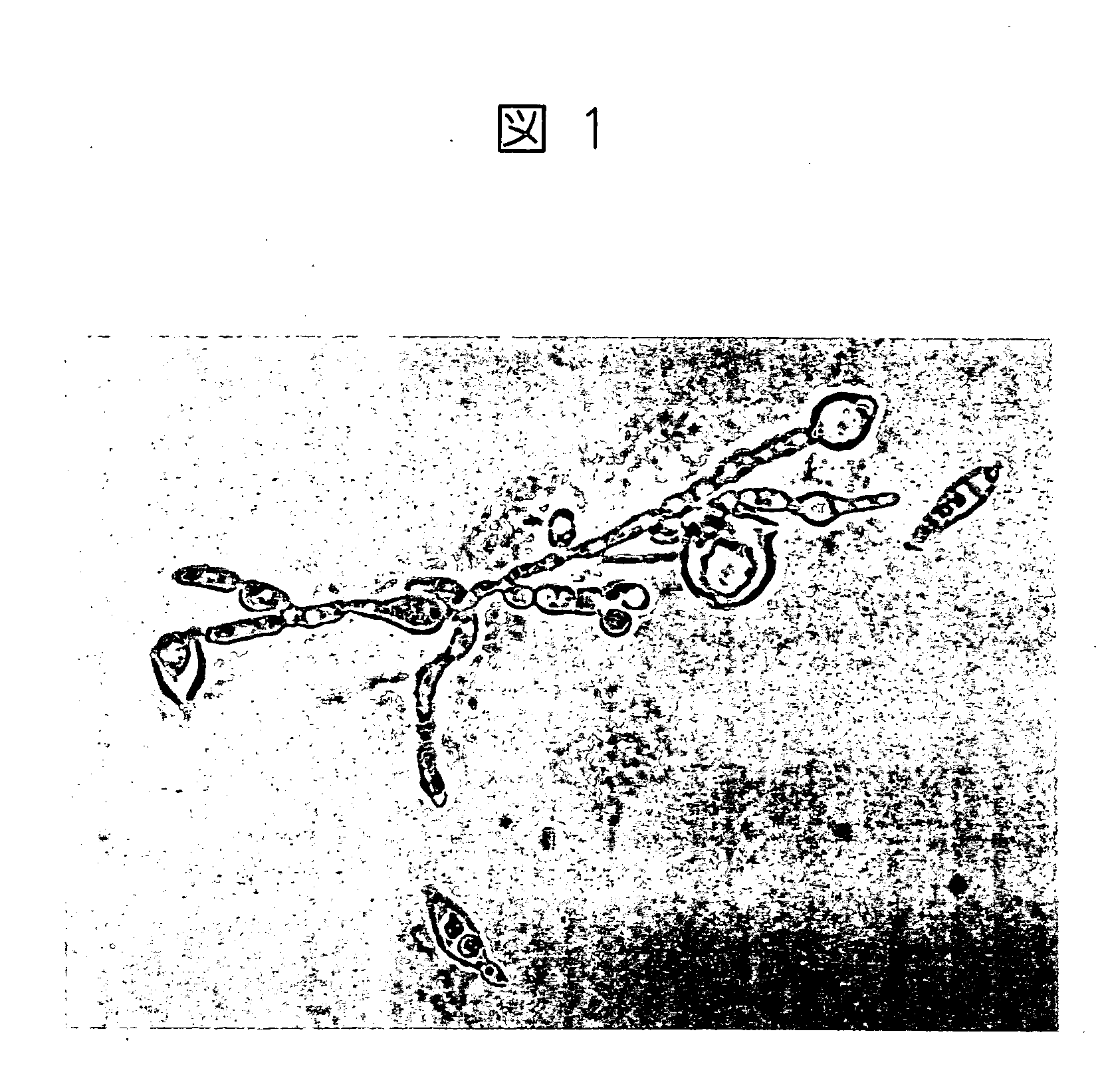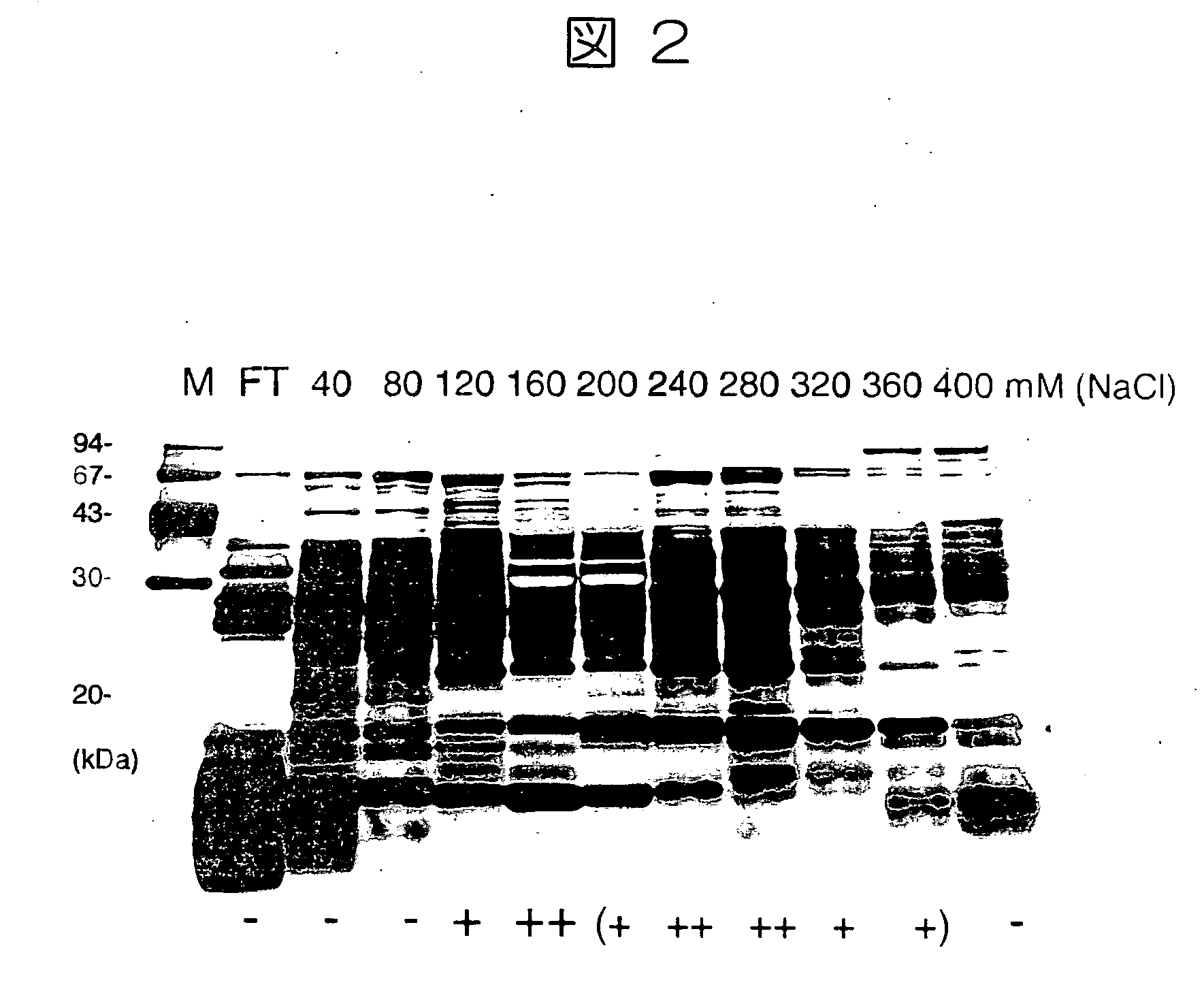Novel protein, genes encoding the same and method of using the same
a technology of novel proteins and genes, applied in the field of new proteins with antifungal activity, can solve the problems of not being able to obtain transgenic plants having practically acceptable resistance, and extensive damage to rice crops
- Summary
- Abstract
- Description
- Claims
- Application Information
AI Technical Summary
Benefits of technology
Problems solved by technology
Method used
Image
Examples
example 1
Construction of an Assay System
1) Establishment of an Assay System
[0158] Cultivation of pathogenic fungi: Magnaporthe grisea (rice blast) (race 337, strain TUS-1 obtained from, National Agricultural Research Center for Tohoku Region of the Ministry of Agriculture, Forestry and Fisheries of Japan) was cultured on an oatmeal medium (Difco, supplemented with 1% sucrose) to give conidia for use as an inoculum. The spores were stored at −80° C. in 10% glycerol, if necessary.
[0159]Rhizoctonia solani (strain JT872) was cultured on ½ potato dextrose broth (PD, Difco) for 2 days, and three mycelia of about 5 mm were gently ground in ½ PD in a Teflon homogenizer to give hyphal fragments for use as an inoculum.
[0160] These inocula were added to 96-well microtiter plates (Corning) at a density of about 1,000 conidia of M. grisea per well or about 300 hyphal fragments of R. solani per well in 100 μl of ½ PD and incubated in an incubator at 28° C. for 48 hours. The growth of the fungi was mo...
example 2
Purification of Antifungal Protein
1) Antifungal Activity of the Crude Pleurotus cornucopiae Protein Sample
[0162] The culture systems of M. grisea and R. solani were added with a given amount the crude P. cornucopiae protein sample added immediately after starting cultivation, incubated for 2 days (46-48 hours), and then evaluated for an antifungal activity by measuring the absorbance. The results showed that the Pleurotus cornucopiae extract contained a substance having a high antifungal activity against both Magnaporthe grisea and Rhizoctonia solani. Complete inhibition of germination and inhibition of the growth of hyphae were observed against M. grisea and inhibition of the growth of hyphae was observed against R. solani. As for cells of M. grisea, the cytoplasm was separated from the cell wall and looked like plasmolysis.
[0163] To further analyze the nature of the antifungal activity detected, residual activity was tested after heating. The antifungal assay was performed aft...
example 3
Isolation of cDNA
1) Determination of the Amino Acid Sequence of Pleurotus cornucopiae Antifungal Protein
[0172] The Superose 6 fraction obtained as above was concentrated on an Ultrafree MC 10,000 NMWL (Millipore) and subjected to SDS-PAGE electrophoresis. The fraction was transferred to a PVDF membrane (Millipore) in a buffer system containing neither Tris nor glycine, and lightly stained with Coomassie Brilliant Blue R-250 and then destained. Then, the protein band of 15 kDa possibly contributing to an antifungal activity was excised. The protein of 15 kDa was partially digested with lysyl endopeptidase (Wako Pure Chemical Industries) or V8 protease (Wako Pure Chemical Industries).
[0173] As a result, a 14 kDa fraction was obtained by digestion with lysyl endopeptidase and 14 kDa and 12 kDa fractions were obtained by digestion with V8 protease. These bands were also transferred after migration. Then, the N-terminal amino acid sequence was determined by Edman degradation using a ...
PUM
| Property | Measurement | Unit |
|---|---|---|
| Fraction | aaaaa | aaaaa |
| Fraction | aaaaa | aaaaa |
| Fraction | aaaaa | aaaaa |
Abstract
Description
Claims
Application Information
 Login to View More
Login to View More - R&D
- Intellectual Property
- Life Sciences
- Materials
- Tech Scout
- Unparalleled Data Quality
- Higher Quality Content
- 60% Fewer Hallucinations
Browse by: Latest US Patents, China's latest patents, Technical Efficacy Thesaurus, Application Domain, Technology Topic, Popular Technical Reports.
© 2025 PatSnap. All rights reserved.Legal|Privacy policy|Modern Slavery Act Transparency Statement|Sitemap|About US| Contact US: help@patsnap.com



